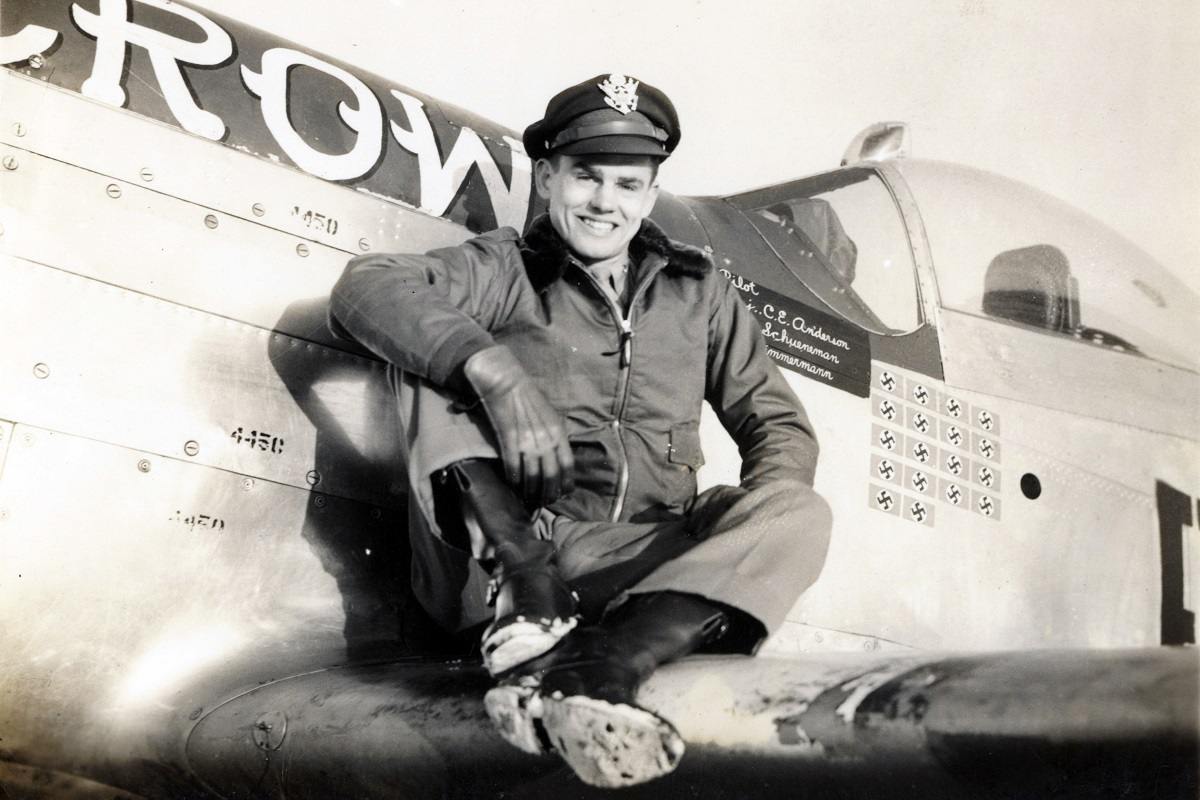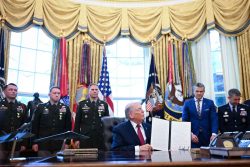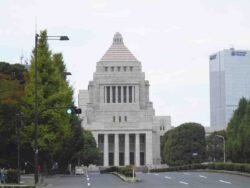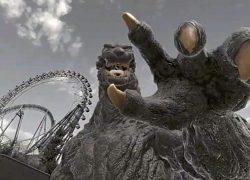
Clarence E. “Bud” Anderson Jr., in the cockpit of his P-51 Mustang, was the last living triple ace pilot of World War II.
13:13 JST, May 22, 2024
Clarence E. “Bud” Anderson Jr., a military pilot whose aerial derring-do spanned from World War II, when he personally shot down 16 German planes in dogfights over occupied Europe, to experimental flights in the era of the jet, died May 17 at his home in Auburn, Calif. He was 102.
His daughter, Kitty Burlington, confirmed his death but did not cite a cause.
In military parlance, a flying ace is an aviator credited with downing five or more enemy planes. With his 16 “kills” – 16 ¼ to be precise, including one that was a group effort – Anderson earned the title three times over.
He was the last surviving triple ace pilot from World War II and a symbol among military aviation buffs of the courage that propelled a generation of young American pilots into epic aerial combat thousands of miles from home.
Anderson retired from the Air Force in 1972 as a colonel and two years ago received an honorary promotion to the rank of brigadier general. Drawn to the skies since he was a boy, he enlisted in the Army Air Forces practically the moment he became eligible, at age 20, six weeks after the Japanese attack on Pearl Harbor precipitated the U.S. entry into World War II.
After training, Anderson arrived in Europe in late 1943. He was stationed in England and became one of the first pilots to fly the P-51 Mustang, a propeller fighter plane that was introduced amid intense battle with the German air force, known as the Luftwaffe, and helped change the tide of the air war in Europe.
Earlier U.S. fighter planes lacked the range to escort bombers deep into German territory and back, which left the bombers vulnerable to attack and resulted in substantial U.S. losses, said John Curatola, a military historian at the National World War II Museum in New Orleans.
The introduction of the P-51 Mustang “helped turn the tables on the German Luftwaffe,” Curatola said. The plane could protect the bombers on their missions from start to finish. And, with its superior maneuverability and formidable firepower, he added, “in the hands of a skilled pilot like Anderson … it’s an extremely deadly weapon.”
Anderson named his P-51 “Old Crow.” Raised by teetotaling parents, he professed in some company that the name referred to “the smartest bird in the sky.” Friends in other circles knew that the moniker was, in fact, a nod to his preferred brand of bourbon.
P-51 pilots flew alone. By the time Anderson was flying, their mission was twofold: to escort bombers to their targets and get them safely home, and to go after Luftwaffe planes and take them down.
Dogfights, lasting only a minute or two, were spectacular bursts of marksmanship as well as airmanship, with pilots guiding their planes while simultaneously firing machine guns located in their wings.
“Death comes quickly and violently in the air war,” Curatola said. “There aren’t many aces because it’s a very difficult skill to shoot down another aircraft moving at 300 to 400 miles per hour while you’re moving at 300 to 400 miles per hour.”
One of Anderson’s squadron mates was Chuck Yeager, who later became a test pilot and broke the sound barrier in 1947.
“On the ground, he was the nicest person you’d ever know,” Yeager wrote of Anderson in a 1985 autobiography, “but in the sky, those damned Germans must’ve thought they were up against Frankenstein or the Wolfman; Andy would hammer them into the ground, dive with them into the damned grave, if necessary, to destroy them.”
During two tours in Europe, Anderson flew 116 missions totaling 480 hours in combat. In all, he was credited with 16¼ confirmed kills and two probable kills in addition to damaging two more enemy planes, according to the American Fighter Aces Association.
Clarence Emil Anderson Jr. – always known as Bud – was born on Jan. 13, 1922, in Oakland, Calif., and grew up in Newcastle, northeast of the state capital of Sacramento. His mother worked as a secretary to several California governors, and his father was a rancher.
Anderson earned his pilot’s license in 1941, at age 19, through the Civilian Pilot Training Program. His best friend also became a pilot and was killed in Germany in 1943 on one of his first missions.
Years later, in an interview for the film series Memoirs of World War II, Anderson said that one of the most painful experiences of his life was visiting the man’s grieving widow when he was home on leave. Consoling one another, they agreed to stay in touch by mail.
In February 1945, when Anderson was home after his second tour in Europe, they were married. Eleanor Cosby Anderson died in 2015. Besides their daughter, of Raleigh, N.C., survivors include a son, Jim Anderson of Mesa, Ariz.; a brother; four grandchildren; and five great-grandchildren.
Of the 28 pilots who deployed with Anderson at the outset of his service, half were killed or taken prisoner by the end of the war, he said. “You come home and there’s an empty bunk over there at night,” he said. “Each guy had to figure out how to cope with that. Some guys just could pull the shade down and ignore it. Some people would not make friends – close friends – because of it.”
After World War II, Anderson became a military test pilot, serving as chief of fighter operations at what is now Wright-Patterson Air Force Base near Dayton, Ohio. He commanded a fighter squadron in Korea and a tactical fighter wing during the Vietnam War. He received, by the end of his career, two awards of the Legion of Merit, five awards of the Distinguished Flying Cross, the Bronze Star Medal and 16 awards of the Air Medal.
Following his military retirement, Anderson joined the McDonnell Douglas aircraft corporation as manager of the company’s flight test facility. According to his website, he flew more than 130 types of aircraft, accumulating more than 7,500 flying hours. With Joseph P. Hamelin, he wrote an autobiography, “To Fly and Fight: Memoirs of a Triple Ace.”
Although proud of his membership in the elite group of triple aces, Anderson was quick to note that World War II was not won alone by the heroes who most often receive the glory. Among those who shared the credit for his achievements, he said, were the members of his ground crew.
Once, he told the publication Aviation History, he returned from a wintertime flight over Germany and made an offhand comment that perhaps Old Crow’s olive-green paint should be replaced with a color that provide better camouflage in the snow.
The next morning, he awoke to see the sunlight glinting off the plane’s original aluminum. The crew had “stayed up the whole night through, hand-rubbing the paint off with rags soaked in gasoline,” he said. “In the process, they had rubbed most of the skin off their hands.”
“No one asked them to do that. No one expected it,” Anderson continued. “Old Crow was as much their plane as mine. They took as much pride in the things it accomplished as I did.”
"News Services" POPULAR ARTICLE
-

American Playwright Jeremy O. Harris Arrested in Japan on Alleged Drug Smuggling
-

Taiwan President Shows Support for Japan in China Dispute with Sushi Lunch
-

Japan’s Nikkei Stock Average as JGB Yields, Yen Rise on Rate-Hike Bets
-

Japan’s Nikkei Stock Average Licks Wounds after Selloff Sparked by BOJ Hike Bets (UPDATE 1)
-

Japanese Bond Yields Zoom, Stocks Slide as Rate Hike Looms
JN ACCESS RANKING
-

Japan’s Hopes for Seafood Exports Shot Down in China Spat
-

Keidanren Chairman Yoshinobu Tsutsui Visits Kashiwazaki-Kariwa Nuclear Power Plant; Inspects New Emergency Safety System
-

Japan to Charge Foreigners More for Residence Permits, Looking to Align with Western Countries
-

Imports of Rare Earths from China Facing Delays, May Be Caused by Deterioration of Japan-China Relations
-

Japan Exports Rise in October as Slump in U.S. Sales Eases

























